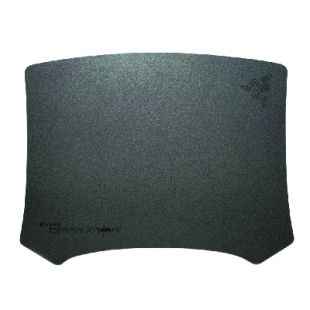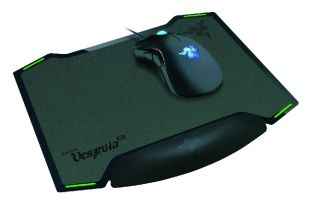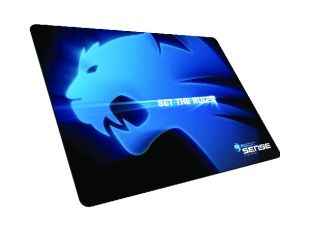Gaming peripheral test 2010: Mousepads
Some might question the sanity of buying a discrete gaming mat, although any gamer worth his DX11 graphic card will scoff at the very notion of using cheap mousepads. Gaming mousepads are usually designed ground up for use with a particular series of mice. The surface is typically larger, since while gaming there’s a lot more mouse movement. The surface is also made of special materials that offer the perfect balance between slide and grip, of course this is optimised for a particular type of mouse, as different mice have different feet. If you are wondering whether a gaming mat is for you or not, the answer is simple – if you’re serious about gaming and comfort, you’ll consider one. It also ensures your pricey mouse gets comfortable shoes for its feet, for poorly designed mats can damage or change the characteristics of the Teflon feet used on mice.
Razer Destructor
Razer is known for making gamers happy, and the Destructor seems like a worthy attempt. It’s a deviation from the soft, cloth-based, foam-backed surfaces we’re used to seeing. Instead the Destructor has a hard surface that has just enough texture to be termed as “unsmooth”. In fact the texture is similar to very fine sandpaper – although it’s not abrasive to your fingertips. There is a thin layer of soft rubber on the rear side of the hard surface, and this provides excellent grip – the mat will not slide on the table, no matter how hard you try. The mat ships in a fancy, rigid zipper case that should easily protect it from most wear and tear.
While testing we couldn’t help but notice how wide this mat is – great for gaming, where mouse movements are erratic and sudden and the travel distance is a lot. Tracking is very, very accurate, and this is not something limited to Razer mice. We found even Logitech’s MX 518 and G500 gaming mice tracked wonderfully on this surface, although coming from a cloth-weave-based gaming mat you’ll need to adjust to the relatively higher acceleration and slightly lower initial resistance that the surface provides. However, accuracy is not sacrificed over speed making the Destructor a truly killer prospect for the competition. We also tried Razer’s own Mamba and Imperator mice on the Destructor, and are pleased to report very good results. The slightly harder Teflon feet on the Deathadder are not as conducive to the slide on the Destructor, but the Mamba and the Imperator glide effortlessly, and despite the slickness there’s accuracy when you want it.
The surface is easier to clean than cloth weaves – a nice plus. Additionally it seems to wear well, although we’ve hardly used it long enough to comment on longevity. Just make sure it’s cleaned well, because any dust causes it to lose grip, and causes erratic mouse movement. Cloth mice have gaps between the weave that fill with dust, there’s nothing of the sort here, a wipe with a smooth cloth and you’re done. Its well suited to FPS games and RPGs fans alike; the price of Rs. 2,599 is expensive for some, but it’s an excellent product. We haven’t used this long enough to comment.
Razer Vespula
Razer’s Vespula has roughly the same contours as the Destructor, though it is a lot smaller. Build quality seems top notch and the Vespula is a rigid mat. The actual body seems to be made of hard, yet slightly flexible fibre, to which are attached, two mouse surfaces – one on each side. This mousepad is two sided, (as you may have guessed), and both sides have rubber feet on all four corners to keep it from moving around. This is no cloth surface. Rather the material as described by Razer is an abrasion-resistant hard coat. One of the surfaces on the Vespula is a smooth finish, while the other side has a noticeably more abrasive surface. The smooth surface is called “glide” by Razer, while the other, rougher one is known as “control”.
While Razer advertises that these surfaces wear well, and we have no doubt that they do, such surfaces usually wreak havoc on the Teflon feet of the mice. We tried a variety of mice on the Vespula and needless to say it’s a pretty decent performer. The surface of the Destructor is actually slap bang in between these two surfaces – it’s smoother than the control, but rougher than the glide. The Mamba performs well on the Vespula, a very smooth experience – effortless gliding on the smooth surface. The mouse acceleration is also good, but not erratic. The Destructor might be a little more precise, but there’s a hairsbreadth separating the two. Interestingly, the Logitech mice, particularly those with the older, harder Teflon feet make a noticeable sound when moving on both surfaces, whereas the Mamba and Imperator do so silently. The Logitech is also quite accurate on both surfaces, but with the scratching sound. Mouse acceleration is not as good as the Razer mice. The Deathadder feels even rougher than the Logitech G5, since it too, features the same old mouse feet.
Priced at Rs. 1,999, the Vespula is a good buy considering you essentially get two micepads for the price of one. However, both surfaces are quite different, and it’s only gamers that would appreciate and utilise the differences fully. Beware though, for the rougher of the two surfaces could well affect longevity of your mice’s feet.
Roccat Sense
Roccat’s Glacier is a huge mat, measuring 480mm x 280mm. It features a more traditional cloth surface. Roccat claims to use a microcrystalline coating on the surface that increases smoothness by reducing friction between the Teflon feet of the mouse and the surface of the pad. The rear is rubber that offers superior grip on any surface, meaning your mat will not slide around despite frantic mouse movements.
Initially, the Mamba seemed to track freely on the Sense. After the first minute of use, we found the cloth surface, although smooth to offer marginally more initial resistance, especially when movements are slow and deliberate. Twitch movements are fast, and response is immediate. In fact, with fast movements slight overtracking happens. We tested this with the Mamba at 2,000 dpi and found the mouse pointer tends to overshoot the target; it’s almost like once the initial friction is over, the mouse glides like butter. The Logitech G5 also worked nicely on the Sense – good accuracy, and there’s marginally less of a problem with initial resistance. Once you get used to the characteristics of the Sense, there are virtually no problems, however, like all cloth mice, you need to ensure the surface stays clean and doesn’t pick up dust. One plus is, the surface seems to be more tightly woven than the surface of the Everglide Titan. It’s also a thinner mousepad, this is important, since you wrist is marginally lower, decreasing strain and also affecting human performance favourably.
Priced at Rs. 1,399, the Sense is rather affordable, though anyone but gamers will gawk at this statement. Those wanting unerring accuracy and tracking might prefer the Destructor, since that seems to favour the Razer mice, endowing them with a good mix of speed, accuracy and seamless movement. For many, the slight initial resistance will not be felt, but the discerning few might want to check the Sense out, before buying it.



